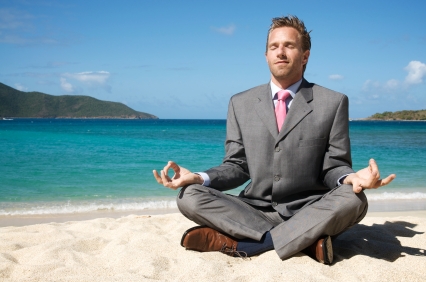With mindfulness and meditation being popular topics these days, everyone seems to be writing about it – and whilst this raises awareness of what, I believe, to be a great practice, it can also lead to some warped perspectives (especially regarding what it can / can’t do AND what it was intended to do / not intended to do).
When I shared with a friend what I would be blogging about this week, she said to me “but won’t that put people off?”. And yes, there might be some people reading what follows and decide “ah well, its not for me then”. But I believe where we (the mindfulness profession) need to work harder is in helping people understand what it is they are entering, the work involved, and the degree to which meditation can help them. Meditation is not a quick fix. And it is only by being up front about this that we begin to address the significant dropout from the practice. This is especially true regarding the “8-week” model (of mindfulness-based stress reduction and mindfulness-based cognitive therapy): speaking with other teachers, their guesti-mate is that less than 10% of people are still practicing a year after the course.
So, here starts the myth busting…
Myth #1: Meditation will help me stop thinking

If this is what you have heard, or this is your intention when you sit down to practice…Good luck! Our mind / brain isdesigned to think, and thank goodness it does, as it helps us navigate our lives. With over a 100 billion neurons in our brain all carrying electrical signals, it is unrealistic to think we can control its activity. Rather, if we can shift our perspective to one that sees this electrical activity creating thought, and sometimes the randomness of that, we can begin to loosen an expectation to reach a blank mind. What we aim to do when we meditate is to notice the thoughts that come up and change our relationship to them: revelling in “nice” thoughts, fighting against “negative” thoughts, or just getting lost in the story – instead, the aim becomes the same: we say “hello” and then let them go (as easily as they entered).
Myth #2: I’m no good at meditation
When I teach on introductory workshops, I am always struck by how people come saying they have tried meditating before but gave it up because “I was no good at it” (the fact they come and give it another go probably suggests they know that isn’t true!). Their value judgement probably relates to Myth #1 – because they have had no success in stopping thoughts, they think it is their incompetence and personal failing! And, even when working with more experienced meditators, the use of language (“that wasn’t a good practice, I was really distracted”) indicates there is still an expectation that the blank mind is somewhere to arrive.
Yet, this is a practice. I mentioned in a post the other week that there are two “mind muscles” we are aiming to train, those of mindfulness and awareness. Quite simply, when we are flexing one or the other, we are training. When we notice we aren’t with the breath, that is our awareness muscle in action; when we are with the breath, our mindfulness muscle is being flexed. So, if you ever have an experience of “tut, I’m always thinking and having to bring myself back to the breath”, then GREAT! You noticed, and you came back.
So, if we have to use value judgements: if you lose your breath 100 times in a sitting, as long as you bring yourself back 100 times, that has been a good practice!
Myth #3: Meditation will reduce stress
 I’ve recently been compiling some research on how Buddhist-informed psychotherapists bring the teachings and meditation in to their therapy work. In the interviews, whilst all of the participants came to the meditation path to work with some aspect of stress or wanting to change their lives, all of the therapists also re-called how beginning a practice of meditation actually ramped up the sense of suffering or life disatisfaction. This is not good for the stereotypical view that meditation takes to you an idyllic beach location!
I’ve recently been compiling some research on how Buddhist-informed psychotherapists bring the teachings and meditation in to their therapy work. In the interviews, whilst all of the participants came to the meditation path to work with some aspect of stress or wanting to change their lives, all of the therapists also re-called how beginning a practice of meditation actually ramped up the sense of suffering or life disatisfaction. This is not good for the stereotypical view that meditation takes to you an idyllic beach location!
This is not to say that you won’t experience a sense of relief / release from starting a practice. Undoubtedly you will. But, firstly it takes time to see the effects, and also to realise that its not that the stress goes away (welcome to what it is to being human) – we change the relationship to our stress. We see it more clearly, and we see our part on what we do to perpetuate it.
We can think of this in an equation…
Stress = pain +/- resistance
In otherwords, the degree to which we will experience stress depends on how much we struggle against things when they don’t go our way (whether that be physcial pain or the pain of seeing our bank balance in the red). This isn’t resignation, but rather seeing things for what they are. In meditation we learn to see these painful things arise, we watch them, we let them go. This helps us do the same thing in life.
Myth #4: Meditation is a useful a tool
An error in thinking of meditation in this way is that it is not designed as a ‘standalone’ practice. When we need to fix two pieces of word together, or hang up a picture, we might reach for a hammer: a tool to use with nails. Meditation is not a tool that we pick up to work with our stress, anxiety, depression, a bad day at the office, an arguement with a family member. It is more than that (we could say it holds the entire tool box, but even that suggests it as a utility). Meditation is said to be “a long path”: it is something we bed down, repeat…and only then can its effects be fully felt. It provides a foundation upon which we can live, relate, be.
pieces of word together, or hang up a picture, we might reach for a hammer: a tool to use with nails. Meditation is not a tool that we pick up to work with our stress, anxiety, depression, a bad day at the office, an arguement with a family member. It is more than that (we could say it holds the entire tool box, but even that suggests it as a utility). Meditation is said to be “a long path”: it is something we bed down, repeat…and only then can its effects be fully felt. It provides a foundation upon which we can live, relate, be.
Yes, we learn a technique, but this only helps us to learn how to “just sit” and be.
“Truth has nothing to do with words. Truth can be likened to the bright moon in the sky. Words, in this case, can be likened to a finger. The finger can point to the moon’s location. However, the finger is not the moon. To look at the moon, it is necessary to gaze beyond the finger, right?”
Meditation practice is like the fingers that point to the way-of-being. “It” is not the moon itself. We learn the technique to help us notice and deconstruct the barriers to “just sitting”, like boredom, anger, fear. For me, this is where I see meditation and therapy coming together: we meditate and get to know our minds and how difficult it is to “just be”; we then take the resistance and content to therapy.
Myth #5: Meditation is selfish
I have been particularly affected by this view, losing friends who considered my practice as pointless. They could not understand why I would sit for extended periods, or go on retreat. At best it was labelled ‘navel gazing’. This can also be said as “meditation causes people to withdraw from the world”. I agree that some people DO look to the meditation path to escape the world, so we have to look at the balance of drawing inward and extending out in to the world and connecting with others.
It is my belief, and experience, that it is only by getting to know our own minds, our own reactive patterns, our own resistances that we can offer more authentic connection with others. If I know my mental, emotional world, I am better in relationships: I imagine many of my close friends and family would testify to this, having seen me change in the 7 years I have been practicing.
I would agree that meditation helps us become more self-aware – and that can mean we start to look out for our needs and having those met. However, if people see this as you being selfish, maybe the relationship terms weren’t balanced in the first place?
Myth #6: Meditation is all about the mind
Okay, I know I said 5, but then I couldn’t leave this one out: quite simply, one of the best bits of advice I was given was to meditate from the body – and I try to get this across now when I teach the practice. We (in the West) can be so in our heads that we end of doing the practice intellectually rather than experientially. Meditation, with the most common object being the breath, is a very physical practice. In the 8-week courses, the first practice we teach is the body scan, and I think this sets a skilful compass from the very start – we have to know our whole self, to be aware of the full-body experience, in order to be truly present in our lives. So, rather than watching the breath, we ARE the breath: as if we are feeling the breath from the inside out. There is no separation between body and mind.
To learn more about meditation and our perspective on bringing these ancient mindfulness practices in to modern-day living, take a look at our forthcoming courses or our regular weekly classes.
